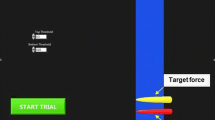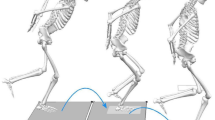Abstract
Purpose
Altered quadriceps muscle activity can contribute to reduced ability of the muscle to quickly generate force and appropriately attenuate landing forces, exacerbating poor landing and movement strategies commonly seen after anterior cruciate ligament reconstruction (ACLR). The purpose was to evaluate if electromyographic (EMG) activity and knee biomechanics during a single-limb forward hop task are influenced by a history of ACLR.
Methods
Twenty-six individuals with a history of unilateral ACLR (age 20.2 ± 2.7 years, height 1.7 ± 0.1 m; weight 69.6 ± 12.4 kg; time from surgery, 2.9 ± 2.7 years; graft type, 21 bone-patellar-tendon bone, 5 hamstring) and 8 healthy controls (age 23.3 ± 1.8 years, height 1.7 ± 0.1 m; mass 66.3 ± 13.9 kg) volunteered. Sagittal plane knee kinetics and EMG of the vastus lateralis were synchronized and measured using a three-dimensional motion analysis system during a single-limb forward hop task. Mixed-effect models were used to assess the effect of group on kinetic and EMG variables.
Results
Kinetic outcomes (peak and rate of knee extension moment) and temporal muscle activity and activation patterns differed between the ACLR limb and healthy-control limb. Inter-limb asymmetries in the ACLR group were observed for all variables except EMG onset time; no limb differences were observed in the healthy cohort.
Conclusion
Years after ACLR, persistent quadriceps functional deficits are present, contributing to altered neuromuscular control strategies during functional tasks that may increase the risk of reinjury. To counteract these effects, emerging evidence indicates that clinicians could consider the use of motor learning strategies to improve neuromuscular control after ACLR.
Level of evidence
III.
Similar content being viewed by others
References
Besier TF, Lloyd DG, Ackland TR (2003) Muscle activation strategies at the knee during running and cutting maneuvers. Med Sci Sports Exerc 35:119–127
Bien DP, Dubuque TJ (2015) Considerations for late stage ACL rehabilitation and return to sport to limit re-injury risk and maximize athletic performance. Int J Sports Phys Ther 10:256–271
Borotikar BS, Newcomer R, Koppes R, McLean SG (2008) Combined effects of fatigue and decision making on female lower limb landing postures: central and peripheral contributions to ACL injury risk. Clin Biomech (Bristol, Avon) 23:81–92
Chang EW, Johnson S, Pollard C, Hoffman M, Norcross M (2018) Landing biomechanics in anterior cruciate ligament reconstructed females who pass or fail a functional test battery. Knee 25:1074–1082
Di Stasi SL, Logerstedt D, Gardinier ES, Snyder-Mackler L (2013) Gait patterns differ between ACL-reconstructed athletes who pass return-to-sport criteria and those who fail. Am J Sports Med 41:1310–1318
Friemert B, Franke S, Gollhofer A, Claes L, Faist M (2010) Group I afferent pathway contributes to functional knee stability. J Neurophysiol 103:616–622
Gokeler A, Hof AL, Arnold MP, Dijkstra PU, Postema K, Otten E (2010) Abnormal landing strategies after ACL reconstruction. Scand J Med Sci Sports 20:e12–19
Gokeler A, Neuhaus D, Benjaminse A, Grooms DR, Baumeister J (2019) Correction to: principles of motor learning to support neuroplasticity after ACL injury: implications for optimizing performance and reducing risk of second ACL injury. Sports Med 49:979
Grabiner MD, Weiker GG (1993) Anterior cruciate ligament injury and hamstrings coactivation. Clin Biomech (Bristol, Avon) 8:215–219
Holt NC, Danos N, Roberts TJ, Azizi E (2016) Stuck in gear: age-related loss of variable gearing in skeletal muscle. J Exp Biol 219:998–1003
Ithurburn MP, Paterno MV, Ford KR, Hewett TE, Schmitt LC (2017) Young athletes after anterior cruciate ligament reconstruction with single-leg landing asymmetries at the time of return to sport demonstrate decreased knee function 2 years later. Am J Sports Med 45:2604–2613
Johnson AK, Palmieri-Smith RM, Lepley LK (2018) Contribution of neuromuscular factors to quadriceps asymmetry after anterior cruciate ligament reconstruction. J Athl Train 53:347–354
Kline PW, Morgan KD, Johnson DL, Ireland ML, Noehren B (2015) Impaired quadriceps rate of torque development and knee mechanics after anterior cruciate ligament reconstruction with patellar tendon autograft. Am J Sports Med 43:2553–2558
Lepley AS, Gribble PA, Pietrosimone BG (2012) Effects of electromyographic biofeedback on quadriceps strength: a systematic review. J Strength Cond Res 26:873–882
Lepley AS, Gribble PA, Thomas AC, Tevald MA, Sohn DH, Pietrosimone BG (2016) Longitudinal evaluation of stair walking biomechanics in patients with ACL injury. Med Sci Sports Exerc 48:7–15
Lepley AS, Kuenze CM (2018) Hip and knee kinematics and kinetics during landing tasks after anterior cruciate ligament reconstruction: a systematic review and meta-analysis. J Athl Train. https://doi.org/10.4085/1062-6050-334-16
Lewek M, Rudolph K, Axe M, Snyder-Mackler L (2002) The effect of insufficient quadriceps strength on gait after anterior cruciate ligament reconstruction. Clin Biomech (Bristol, Avon) 17:56–63
McLean SG, Fellin RE, Suedekum N, Calabrese G, Passerallo A, Joy S (2007) Impact of fatigue on gender-based high-risk landing strategies. Med Sci Sports Exerc 39:502–514
McLean SG, Lipfert SW, van den Bogert AJ (2004) Effect of gender and defensive opponent on the biomechanics of sidestep cutting. Med Sci Sports Exerc 36:1008–1016
Needle AR, Lepley AS, Grooms DR (2017) Central nervous system adaptation after ligamentous injury: a summary of theories, evidence, and clinical interpretation. Sports Med 47:1271–1288
Oberlander KD, Bruggemann GP, Hoher J, Karamanidis K (2013) Altered landing mechanics in ACL-reconstructed patients. Med Sci Sports Exerc 45:506–513
Palmieri-Smith RM, Lepley LK (2015) Quadriceps strength asymmetry after anterior cruciate ligament reconstruction alters knee joint biomechanics and functional performance at time of return to activity. Am J Sports Med 43:1662–1669
Palmieri-Smith RM, Thomas AC (2009) A neuromuscular mechanism of posttraumatic osteoarthritis associated with ACL injury. Exerc Sport Sci Rev 37:147–153
Pamukoff DN, Montgomery MM, Choe KH, Moffit TJ, Garcia SA, Vakula MN (2018) Bilateral alterations in running mechanics and quadriceps function following unilateral anterior cruciate ligament reconstruction. J Orthop Sports Phys Ther 48:960–967
Pamukoff DN, Pietrosimone BG, Ryan ED, Lee DR, Blackburn JT (2017) Quadriceps function and hamstrings co-activation after anterior cruciate ligament reconstruction. J Athl Train 52:422–428
Paterno MV, Huang B, Thomas S, Hewett TE, Schmitt LC (2017) Clinical factors that predict a second ACL injury after ACL reconstruction and return to sport: preliminary development of a clinical decision algorithm. Orthop J Sports Med 5:2325967117745279
Pfeifer K, Banzer W (1999) Motor performance in different dynamic tests in knee rehabilitation. Scand J Med Sci Sports 9:19–27
Pietrosimone B, Blackburn JT, Padua DA, Pfeiffer SJ, Davis HC, Luc-Harkey BA et al (2018) Walking gait asymmetries 6 months following anterior cruciate ligament reconstruction predict 12-month patient-reported outcomes. J Orthop Res. https://doi.org/10.1002/jor.24056
Pietrosimone BG, McLeod MM, Lepley AS (2012) A theoretical framework for understanding neuromuscular response to lower extremity joint injury. Sports Health 4:31–35
Slater LV, Hart JM, Kelly AR, Kuenze CM (2017) Progressive changes in walking kinematics and kinetics after anterior cruciate ligament injury and reconstruction: a review and meta-analysis. J Athl Train 52:847–860
Snijders TAB (2005) Fixed and random effects. In: Everitt BS, Howell DC (eds) Encyclopedia of statistics in behavrioal science, vol 2. Wiley, Chicester, pp 664–665
Solnik S, DeVita P, Rider P, Long B, Hortobagyi T (2008) Teager-Kaiser Operator improves the accuracy of EMG onset detection independent of signal-to-noise ratio. Acta Bioeng Biomech 10:65–68
Solnik S, Rider P, Steinweg K, DeVita P, Hortobagyi T (2010) Teager-Kaiser energy operator signal conditioning improves EMG onset detection. Eur J Appl Physiol 110:489–498
Thomas AC, Hubbard-Turner T, Wikstrom EA, Palmieri-Smith RM (2016) Epidemiology of posttraumatic osteoarthritis. J Athl Train 52:491–496
Thomas AC, Lepley LK, Wojtys EM, McLean SG, Palmieri-Smith RM (2015) Effects of neuromuscular fatigue on quadriceps strength and activation and knee biomechanics in individuals post-anterior cruciate ligament reconstruction and healthy adults. J Orthop Sports Phys Ther 45:1042–1050
Trigsted SM, Post EG, Bell DR (2017) Landing mechanics during single hop for distance in females following anterior cruciate ligament reconstruction compared to healthy controls. Knee Surg Sports Traumatol Arthrosc 25:1395–1402
Welling W, Benjaminse A, Seil R, Lemmink K, Gokeler A (2018) Altered movement during single leg hop test after ACL reconstruction: implications to incorporate 2-D video movement analysis for hop tests. Knee Surg Sports Traumatol Arthrosc 26:3012–3019
Wren TAL, Mueske NM, Brophy CH, Pace JL, Katzel MJ, Edison BR et al (2018) Hop distance symmetry does not indicate normal landing biomechanics in adolescent athletes with recent anterior cruciate ligament reconstruction. J Orthop Sports Phys Ther 48:622–629
Acknowledgements
This study was in part supported by the International Society of Biomechanics Student Congress Travel Grant 2019.
Funding
No funding was provided for the completion of this work.
Author information
Authors and Affiliations
Contributions
JB, AL, and LL are responsible for the design of the study. JB and LF were responsible for all recruitment and data collection procedures. JB, AL, LF and LL participated in the data analysis and interpretation. JB and LL drafted the manuscript. All authors read and approved the final manuscript.
Corresponding author
Ethics declarations
Conflict of interest
The authors declare that they have no conflict of interest.
Ethical approval
Ethical approval was agreed by the ethical committee of the institution.
Additional information
Publisher's Note
Springer Nature remains neutral with regard to jurisdictional claims in published maps and institutional affiliations.
This study was approved by the University of Connecticut’s Institutional Review Board.
Rights and permissions
About this article
Cite this article
Burland, J.P., Lepley, A.S., Frechette, L. et al. Protracted alterations in muscle activation strategies and knee mechanics in patients after Anterior Cruciate Ligament Reconstruction. Knee Surg Sports Traumatol Arthrosc 28, 3766–3772 (2020). https://doi.org/10.1007/s00167-019-05833-4
Received:
Accepted:
Published:
Issue Date:
DOI: https://doi.org/10.1007/s00167-019-05833-4




